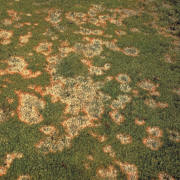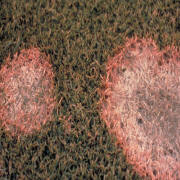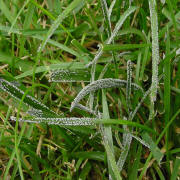|
Mold Diseases
As snow melts each spring, lawns often show
damage from the winter. Mold Damage can be very destructive to lawns. There are
preventative measures to take to minimize the damage.
Snow mold damage appears in the spring when the snow melts creating visually
unattractive matted, crusty looking areas on your lawn. As they dry out
throughout the season, the infected areas may remain in the form of weak or even
dead turf. If your grass is dead then you will have to reseed, which can become
costly if it is an annual problem. Severity of the mold may vary yearly, but the
areas that are infected may weaken and spread. Fertilization programs are
offered to lessen the risk of snow mold. A simple solution to prevent mold is
removing dense vegetation bordering the problem area of the lawn and mowing
until the lawn is dormant in the fall.
Slime molds are different from most other turfgrass pathogens in that they do
not directly infect the plant. Instead, this group of organisms feeds on
microorganisms and decaying organic debris. During periods of warm, wet weather,
slime molds migrate onto the surfaces of turfgrass leaves where they produce
massive amounts of their reproductive structures, thus producing a white, blue,
or gray patch. Slime molds do not damage turf (apart from shading) and can be
removed by sprinkling the leaves with water after the onset of dry weather.
Removal of the dry spore masses by mowing, raking, brushing, or sweeping with a
pole will aid in returning the grass to normal appearance. Chemical control is
not necessary.
Fairy rings typically appear as rings of
dark green and fast-growing turf. They may also appear as rings of slow-growing
or killed turf. The bands of affected turf are from 4 inches to a foot in width,
forming more or less continuous rings ranging from 3 to 200 feet across. In some
instances, the center of a stimulated band may contain weakened or dead grass,
or bands may have an inner zone of stimulated grass edged with dead or stunted
turf on either side. Fairy rings are produced by colonies of mushroom fungi that
live in soil and thatch. These colonies obtain food from decaying organic matter
and grow outward radially, increasing in size year after year. The ring of
stimulated grass is thought to be caused by nitrogen substances produced by the
breakdown of organic matter by the fungi. The fungi usually do not attack grass,
but sometimes they repel water, resulting in death of the turf due to drought.
The causal fungi are spread when fungal threads, bits of mushrooms, or spores
from the mushrooms are introduced into soil under a turf area.
Lawn King, LLC
performs turf disease scouting when we perform each fertilizer application. If
there is a problem, we will inform you as to the type of disease, the severity
and if treatment is required. Of course, as a team, (you and I) if you notice a
problem, you should contact us immediately. |



